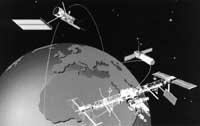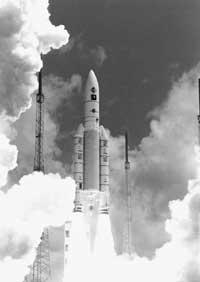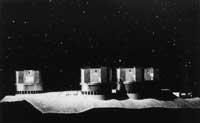ESA above all mists
1996/03/01 Elhuyar Zientzia Iturria: Elhuyar aldizkaria
Last autumn the Council of Ministers of the European Spacial Agency (ESA) held a meeting in which the head of the organization presented the program “Horizon 2000 Plus”. If the political leaders accept it, it will be followed by Horizon 2000 which will be in force until 2006. The presentation of the project does not come at a bad time.
It seems that public opinion, and with it policies, have forgotten the problems that the SNA had until the beginning of the decade with space ferries, or the manufacturing error of the Hubble Space Telescoke (in which ESA also participated) and, in recent times, have gained more weight other achievements of great prestige. It is worth noting the information offered by the COBE about the inhomogeneities existing in the early phases of the Universe, the discoveries that the HST provides us from time to time (for example, from the galaxies announced at the beginning of the year) or the information that the Galileo probe sent us in December last year by immersing us in the atmosphere of Jupiter (found much less water than scientists expected).
We have said that it is a good time to make this announcement and, without a doubt, the environment that has arisen around the Alpha project has been good for the intentions of the director of ELA. In fact, the space agencies of the United States, the Confederation of Independent States, Europe, Canada and Japan are carrying out at the end of next year the work they are carrying out to start building the Alpha space platform, which has made the international association unable to move forward for years.
Because NASA cannot meet the budget, this project has been rejected four times (with so many other names, the latest Freedom). However, for some, the advantages that a space platform can offer do not justify in any way this great investment, but if it is analyzed as an international project and in the context of the disarmament agreements, the most optimistic also consider that it can be a way of reconversion of the sector of the arms industry.
Given this background, the “Horizon 2000 Plus” program will delve into three major areas of research: Solar System, Extrasolar Astronomy and Basic Physics.
As for the solar system, the most important project is the mission to Mercury, the most unknown inner planet. On the other hand, in collaboration with some of the international organizations, there are also projects to study Martitz, Saturn, the Sun's crown and the Earth's magnetosphere.
As for extrasolar astronomy, the first work of scientists was to obtain observations of the electromagnetic spectrum that filters the atmosphere. Since this step is overcome, the works are aimed at the design of second generation observers. More specifically, the works are aimed at the development of astrometry by interferometry, as it will overcome the resolution of HST and allow the discovery of planets around other stars. As for Basic Physics, the main objective is the detection of gravitational waves.
As is known, space instruments do not offer the level of availability of the telescopes we have on Earth and technical and economic problems make the extra-atmospheric medium unable to stock up on satellites at the level that scientists would like. In this sense, satellite observations must complement those made from Earth, but they are certainly essential.
It fulfills the commitment of all States to ESA and it is possible to carry out the new project. So be it!

Gai honi buruzko eduki gehiago
Elhuyarrek garatutako teknologia





